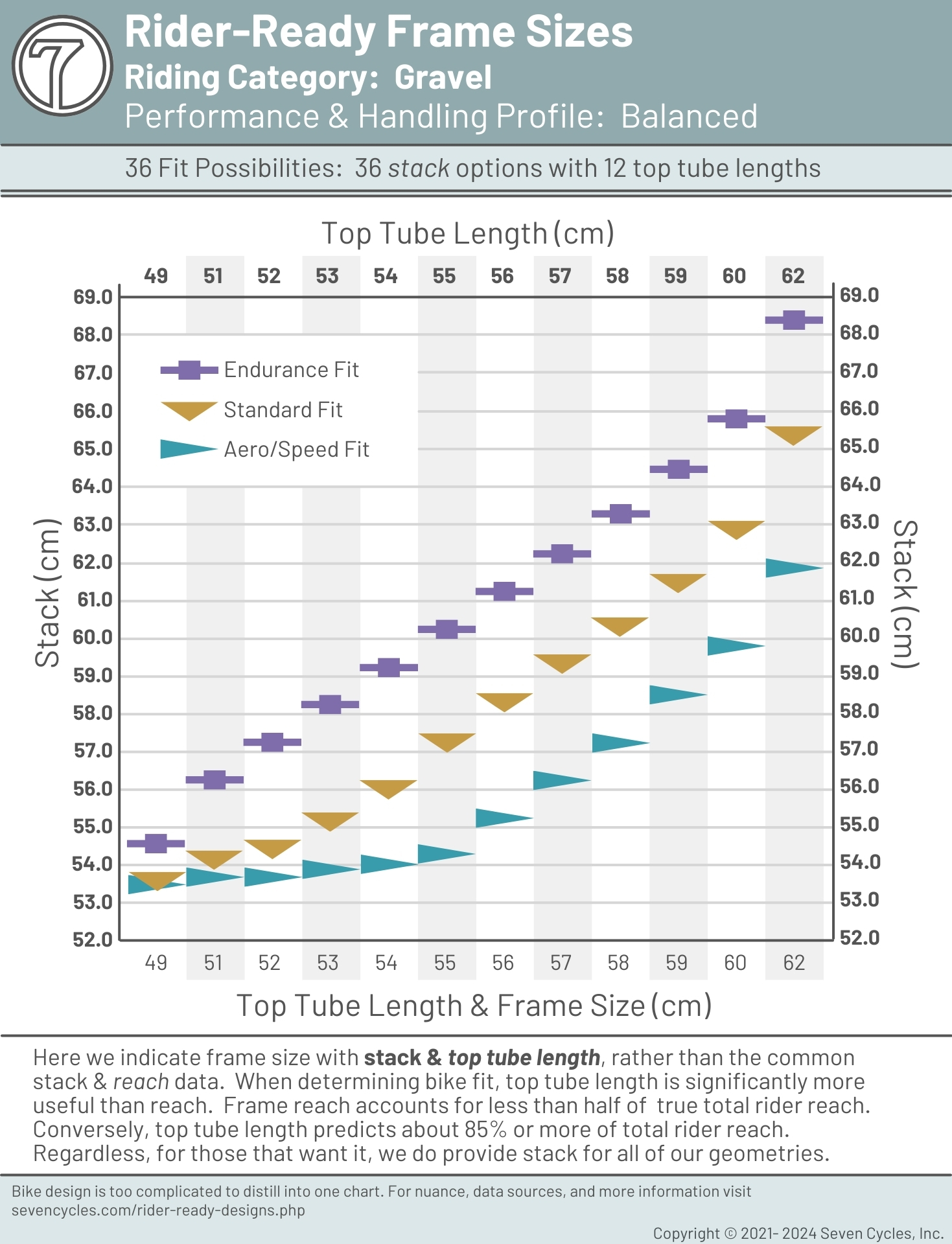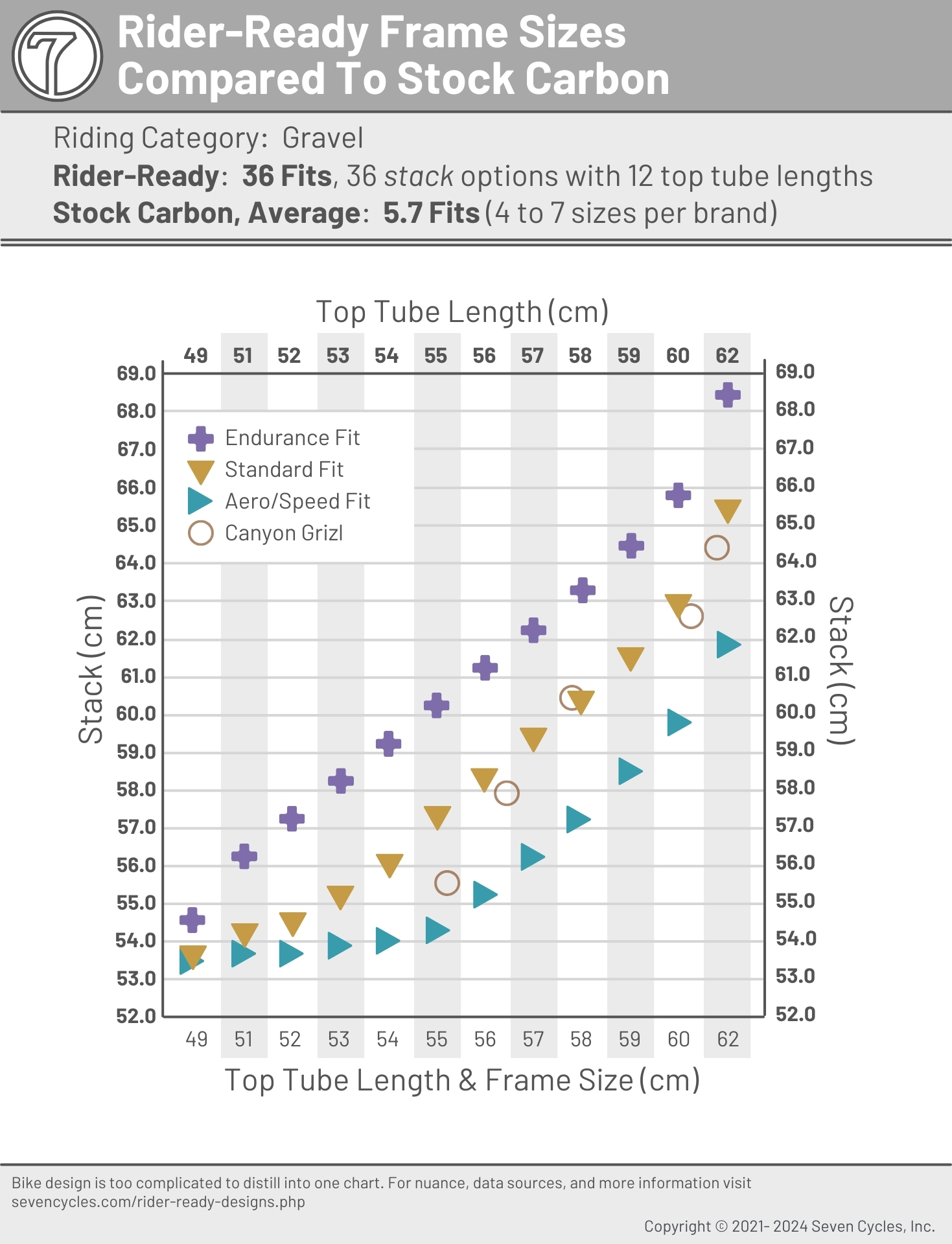Bike Fit: Frame Reach Vs. Top Tube Length
tl;dr: Don't use frame reach as a way to determine ideal frame size. Instead, use top tube length. Stack, combined with top tube length, is a decent metric to determine frame size. xxxxxxxxxxx Use stack and top tube length combined as the two primary frame fit data points.
There are many ways for a fitter to determine the right frame size for a rider. The most popular is to determine "frame stack and reach." That's unfortunate because it's not the best way to choose a stock size bike. There are more effective and easier methods. The most accurate is to replace the frame reach measurement with top tube length measurement. Having said that, no single measurement results in the perfect frame size. However, using top tube length as a single measurement is significantly more accurate than using reach as a single measurement.
Note about the term "reach": Reach is used in too many ways. This causes confusion for normal riders. Reach is commonly used in three ways:
- Frame Reach: The most common use of the term, reach. This is the distance from the bottom bracket measured horizontally to the top face of the head tube's axis. This sound logical but it's a terrible measure for a lot of reasons. Explained below.
- Stem Reach: This is a slightly more useful measurement because it accounts for headset, spacers, stem length and stem angle. It still misses some key elements of choosing the optimal frame size. Explained below.
- Bike Reach: The distance from the saddle to the bars. There are a few ways to measure this. However, the point is that the fitter is considering the holistic bike with the frame, saddle, stem, seat post, brake type, and other elements into account. When Seven refers to reach, this is usually what we mean.
Seven is agnostic regarding how to fit stock frames. If a fitter prefers to use frame reach as a fit data point, we provide frame reaches for all of our bikes. We also obviously provide top tube lengths for all of our bikes. Fitters will use whichever they prefer. Regardless, frame reach is not a good measure for choosing the right size frameset or bike.
More specifically, frame reach is an okay measure for most stock bikes that come in 4 to 7 sizes (an average of 5.7 sizes). As shown in figure 2. The gap between frame reaches will be about one-centimeter when you're choosing between just five sizes. In fact, frame reach at that point becomes almost pointless. When working with so few sizes, stack becomes the overriding concern. Frame reach is a result of finding the least bad stack.
"Frame reach" as a bike fit dimension
The popular measurement "frame reach" is a poor gauge of proper bike fit. The classic "top tube" measurement is much more helpful in determining the right fit of a frameset.
Frame reach misses about xxxxxx % of xxxxxx. Here are some of the factors that frame reach does not and cannot take into account. All of these are significant facets of a bike's true reach. At its most basic and helpful, intuitively, reach means the distance from where you sit on the saddle to the grips. Frame reach provides about half of the data needed to determine an ideal riding reach. Meaning it is impossible to get your ideal fit by using frame reach.
- Frame setback accounts for about 15 cm of reach-like distance on average. For a tall rider, setback can be more than 20 cm.
- Seat tube angle: This can account for a couple of centimeters of fit difference.
- Saddle type and where you sit on a specific saddle can impact your effective reach by 4+ cm.
- Saddle position: The fore-aft adjustment on most saddles is about 4.5 cm. Depending on where your saddle sits on your current bike, it can have a big influence on the true fit of your next bike.
- Seat post type: The obvious is center mount vs. setback post. This is typically about a 2.2 cm difference. And, different setback posts have different set back. The total variance can easily be 2.5 cm or more.
In total, the variance could be nearly 30 cm of missed fit accuracy. On average, it's probably about 20 cm, but that's still a lot of reach information for a fitter forego by thinking that frame reach is a measurement of value.
Now, add stem length and angle variables, often about 3 to 4 centimeters, and the missing elements of frame reach xxxxxxxxxxxxx Stem should be separate? Really you need to factor in stem length because it's inextricable to frame fit.
Really we want to be talking about bike reach, not frame reach. Bike reach accounts for all of these variables. At least it allows for fast comparisons of one bike reach to another. Seven's bike reach uses a bunch of averages that we provide so you can compare your saddle type to our "standard" and our default stem length to the stem length on the current bike xxxxxxxxxxxxxxxxx
xxxxxxxxxxxxx The total reach range is 4.09 cm (1.6"). That's barely anything. For reference, Seven's top tube length range is 13 cm (5.2"), or 315% wider range.
xxxxxxxxxxxxx The provides a more accurate fit becasue the range is wider and therefore more accurage per size.
xxxxxxxxxxxx TT accounts for most of the bike reach. Frame reach accounts for about 40% of the total bike reach.
Frame setback is the distance from the bottom bracket plumb line measured along the horizontal line from the head tube top face's axis back to the seat tube axis. Ironically, adding frame reach and frame setback together account for about 95%+ of the frame's effective top tube length; the term everyone used for decades as a measure of bike fit.
Regardless of frame reach's shortcomings, we include the information because it has become a popular industry shorthand for comparing one bike size to another. While the frame reach numbers Seven shows here are accurate, Seven does not take responsibility for an ill-fitting bike if a fitter chooses to rely on the industry's frame reach standards.
So, how does Seven recommend you determine proper frame size for your ideal fit — assuming you are looking at stock geometries? First, work with a professional fitter. Failing that, use frame stack and effective top tube length as a starting point. However, DO NOT order a bike based on this overly simplistic explanation. Go to a bike fitter.
frame reach adds a layer of confusion. just use top tube length xxxxxxx


